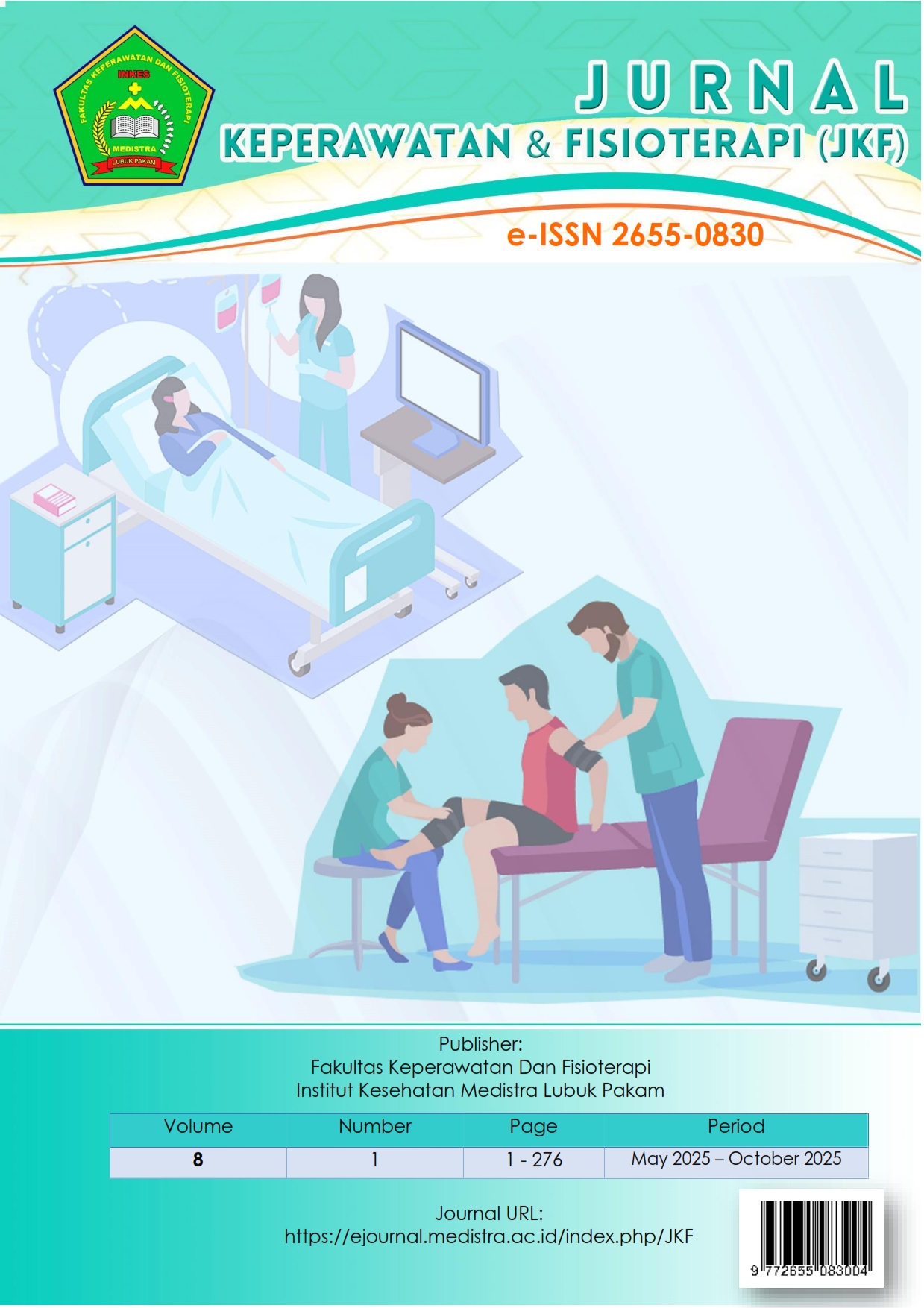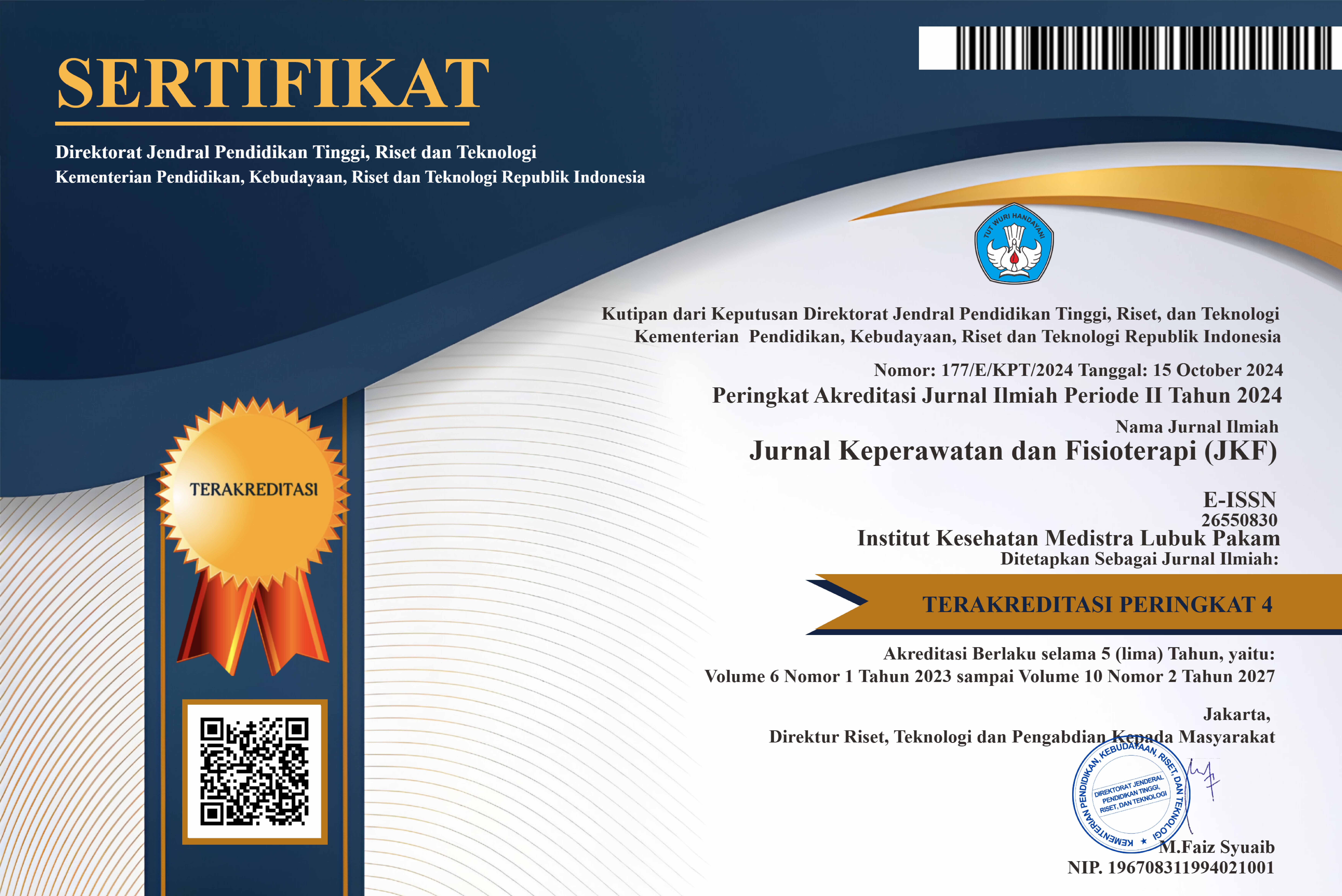CPR Knowledge: The Key to ICU Nurses’ Readiness in Facing Emergency Conditions
DOI:
https://doi.org/10.35451/82p1x098Keywords:
CPR, Cardiac Arrest, Knowledge, ReadinessAbstract
Cardiovascular disease remains the leading cause of death worldwide, and sudden cardiac arrest is a life-threatening emergency that requires immediate management through Cardiopulmonary Resuscitation (CPR). The low survival rate of patients is often attributed to insufficient knowledge and preparedness among healthcare professionals in performing CPR. This study aimed to analyze the correlation between nurses’ level of knowledge and their readiness to perform CPR in the ICU of Grandmed Hospital, Lubuk Pakam. A quantitative method with a cross-sectional and correlational design was employed. The study population included all 19 ICU nurses, selected using a total sampling technique. Data were collected using a structured questionnaire covering respondent characteristics, CPR knowledge based on American Heart Association (AHA) standards, and readiness to respond to emergency situations. Univariate analysis revealed that the majority of respondents were female (68.4%), aged 20–29 years (68.4%), held a professional nursing degree (63.2%), had 1–5 years of work experience (63.2%), and more than half had never attended CPR training (52.6%). Furthermore, 84.2% of nurses demonstrated good knowledge, and 78.9% were categorized as highly ready. The Spearman’s rho test indicated a strong and significant positive correlation between knowledge and readiness (r = 0.629; p = 0.004). In conclusion, the higher the nurses’ level of knowledge regarding CPR, the better their readiness to handle sudden cardiac arrest in the ICU.
Downloads
References
[1] Y. E. P. Yolandini, “Analisis Pada Kematian Akibat Penyakit Jantung Di Rumah Sakit Umum Pusat H. Adam Malik Medan Menggunakan Poisson Ridge Regression (PRR),” Quadratic J. Innov. Technol. Math. Math. Educ., vol. 2, no. 1, pp. 24–30, 2022, doi: 10.14421/quadratic.2022.021-04.
[2] S. Yan et al., “The global survival rate among adult out-of-hospital cardiac arrest patients who received cardiopulmonary resuscitation: a systematic review and meta-analysis,” Crit. Care, vol. 24, no. 1, p. 61, Dec. 2020, doi: 10.1186/s13054-020-2773-2.
[3] A. Sarella, P. Tzela, P. Giaxi, D. Sarantou, A. Bothou, and K. Gourounti, “Safety Considerations and Knowledge Gaps in Maternal Cardiopulmonary Resuscitation: A Systematic Review of Healthcare Professionals’ Preparedness,” Cureus, Aug. 2025, doi: 10.7759/cureus.89683.
[4] G. A. Roth et al., “Global Burden of Cardiovascular Diseases and Risk Factors, 1990–2019,” J. Am. Coll. Cardiol., vol. 76, no. 25, pp. 2982–3021, Dec. 2020, doi: 10.1016/j.jacc.2020.11.010.
[5] T. McGarity, L. Monahan, K. Acker, and W. Pollock, “Nursing Graduates’ Preparedness for Practice: Substantiating the Call for Competency-Evaluated Nursing Education,” Behav. Sci. (Basel)., vol. 13, no. 7, p. 553, Jul. 2023, doi: 10.3390/bs13070553.
[6] J. S. Izquierdo-Condoy et al., “Assessment of preparedness and proficiency in basic and advanced life support among nursing professionals: a cross-sectional study,” Front. Med., vol. 11, pp. 1–9, 2024, doi: 10.3389/fmed.2024.1328573.
[7] M. Wisnu Kanita, L. Aprilia Ayuningsyas, Y. Siti Nurichasanah, and B. Larasati Nurnaningtyas, “Pengaruh Pelatihan Bantuan Hidup Terhadap Keterampilan, Kesiapan Dan Motivasi Penanganan Cardiopulmonary Resuscitation Pada Mahasiswa NERS,” J. Kesehat. Kusuma Husada, pp. 124–132, Jan. 2024, doi: 10.34035/jk.v15i1.1282.
[8] Munawwarah, Aklima, and Fikriyanti, “Pengetahuan Mahasiswa Tentang Resusitasi Jantung Paru,” Jim FKep, vol. VII, no. 4, pp. 24–28, 2023.
[9] D. Oktaviana, M. Alif Zainal, I. Saleh, and S. Tanawali Takalar, “Pengaruh Metode Simulas Basic Life Support Terhadap Tingkat Pengetahuan dan Skill Basic Life Support Siswa UPT SMK Negeri 6 Takalar,” Politek. Kesehat. Makassar, vol. 15, no. 1, pp. 2087–2122, 2024.
[10] N. M. D. Wahyunadi, L. Devi, and I. K. Sudiana, “Faktor-Faktor Yang Berhubungan Dengan Pengetahuan Penata Anestesi Tentang Resusitasi Jantung Paru ( RJP ) Pada Era Pandemi Covid-19 ( Factors Associated With Nurses Anesthetists ’ Knowledge of Cardiopulmonary Resuscitation (CPR) in the Covid-19 Pandemy,” vol. 8, no. 4, pp. 445–454, 2021.
[11] R. M. Husni, O. W. Angkejaya, C. R. Titaley, and S. Syahrony, “Tingkat Pengetahuan tentang Bantuan Hidup Dasar pada Mahasiswa Preklinik Fakultas Kedokteran Universitas Pattimura Ambon Tahun 2018,” vol. 06, no. 03, pp. 16338–16343, 2024.
[12] K. B. Sondergaard et al., “Bystander cardiopulmonary resuscitation and long-term outcomes in out-of-hospital cardiac arrest according to location of arrest,” Eur. Heart J., vol. 40, no. 3, pp. 309–318, Jan. 2019, doi: 10.1093/eurheartj/ehy687.
[13] J. D. Collingburn, S. L. Bourke, and B. Copnell, “Gender diversity in nursing undergraduate curricula: A scoping review,” Nurse Educ. Today, vol. 152, p. 106749, Sep. 2025, doi: 10.1016/j.nedt.2025.106749.
[14] J. Bange, W. Gao, and K. Crawford, “Graduate nurses’ experience of support, training, and education during the COVID-19 pandemic: A qualitative study,” Collegian, vol. 32, no. 2, pp. 120–127, Apr. 2025, doi: 10.1016/j.colegn.2025.02.002.
[15] Y. Fahajan et al., “The effect of a simulation-based training program in basic life support on the knowledge of Palestinian nurses: a quasi-experimental study in governmental hospitals,” BMC Nurs., vol. 22, no. 1, p. 398, Oct. 2023, doi: 10.1186/s12912-023-01552-x.
[16] Z. Kuchaki, M. Taheri, H. Esfahani, and T. Erfanifam, “The effect of CPR educational package on knowledge and performance of nurses working in intensive care units,” J. Fam. Med. Prim. Care, vol. 11, no. 5, pp. 1677–1682, May 2022, doi: 10.4103/jfmpc.jfmpc_1938_21.
[17] S. Nasiri, R. Hosseinabadi, Y. Mokhayeri, and S. Beiranvand, “Impact of flipped classroom-based simulation of CPR on nursing students’ self-confidence, satisfaction, knowledge and skill: a quasi-experimental study,” BMC Med. Educ., vol. 25, no. 1, p. 980, Jul. 2025, doi: 10.1186/s12909-025-07525-9.
[18] A. I. Aedh, E. Abdel-Haliem, and M. Farid, “Knowledge, attitude, and practice of CPR and willingness to perform it among undergraduate medical students of Najran University, Saudi Arabia: a cross-sectional study,” BMC Med. Educ., vol. 25, no. 1, p. 772, May 2025, doi: 10.1186/s12909-025-07344-y.
[19] A. Khaledi, R. Ghafouri, S. Z. Anboohi, M. Nasiri, and M. Ta’atizadeh, “Comparison of gamification and role-playing education on nursing students’ cardiopulmonary resuscitation self-efficacy,” BMC Med. Educ., vol. 24, no. 1, p. 231, Mar. 2024, doi: 10.1186/s12909-024-05230-7.
[20] Z. D. Alaryani, A. Alhofaian, and M. Elhady, “The relationship between knowledge and self-efficacy of nurses regarding early initiation of cardiopulmonary resuscitation and automated defibrillation in Saudi Arabia,” Belitung Nurs. J., vol. 7, no. 5, pp. 387–394, Oct. 2021, doi: 10.33546/bnj.1670.
Downloads
Published
Issue
Section
License
Copyright (c) 2025 Angriawan Angriawan, Ilyas I Made Permata Gusti, Muhammad Reza Fahlevi Hanafi, Nadya Ulfa Kesumawardani

This work is licensed under a Creative Commons Attribution 4.0 International License.
Copyright in each article is the property of the Author.


























